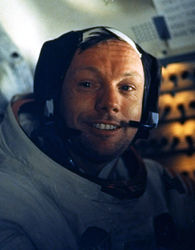A pilot at 16, astronaut Neil Armstrong’s early years were spent in the skies, but his later years have been grounded in academia and the soil itself. After returning from his legendary moon landing, Armstrong retreated from the world’s deafening applause, resigning from NASA the year after his boot touched the lunar surface. He taught college courses for nearly a decade, married twice and raised two children, and returned to farming.
Neil Armstrong’s Early Days
Neil Alden Armstrong was born August 5, 1930, on his grandparents’ farm near Wakoponeta, Ohio. He took his first plane ride at age 6, spurring his interest in flight. As a teenager, Armstrong worked at a nearby airport in exchange for flying lessons, acquiring his pilot’s license before his driver’s license. After high school, he attended Purdue University with a Navy scholarship, suspending his studies in 1950 to fight in the Korean War.
During the war, his plane was shot down and he was forced to make an emergency landing. However, he returned safely to Ohio with three medals and finished his degree in aeronautical engineering.
Sources in this Story
- NeilArmstrongInfo.com: Neil Armstrong Info Timeline
- Encyclopedia Britannica: Neil Armstrong
- Boeing Frontiers: The abbreviated flight of Gemini 8
- findingDulcinea: On This Day: Man Walks on Moon
- The New York Times: In Rural Ohio, Armstrong Quietly Lives on His Own Dark Side of the Moon
- The Cincinnati Enquirer: Neil Armstrong, The Reluctant Hero
- CBS News: 60 Minutes: Being the First Man on the Moon
- Space.com: Neil Armstrong (1930-2012): NASA Remembers an American Icon
Armstrong in Space
Armstrong left the Navy in 1952 and began working for the National Advisory Committee for Aeronautics (NACA), and then for its successor, the National Aeronautics and Space Administration (NASA), as a test pilot.
In 1966, Armstrong flew in space for the first time aboard the Gemini 8. He and David Scott performed the first docking of a spacecraft while in orbit, guiding the Gemini 8 into an unmanned Agena rocket. However, the linked spacecrafts began spinning out of control, forcing Armstrong to make an emergency splashdown in the Pacific Ocean.
In 1967, Armstrong was one of 18 astronauts selected for the Apollo program, and was later named the spacecraft commander for Apollo 11, the first manned mission to the moon. On July 16, 1969, he, Edwin “Buzz” Aldrin Jr. and Michael Collins set off for the moon aboard the Columbia.
Three days into the mission, he and Aldrin entered lunar module, the Eagle, and separated from the Columbia. Armstrong steered the Eagle onto the moon, touching down with just 30 seconds worth of fuel left at 4:18 p.m. on July 20. He radioed, “The Eagle has landed.”
More than six hours later, Armstrong exited the capsule, taking the first steps on the moon’s surface. “That’s one small step for a man,” he declared, “one giant leap for mankind.”
To see a replica of Apollo 11 and learn more about his endeavors, visit the Neil Armstrong Air and Space Museum in Armstrong’s childhood home of Wapakoneta, Ohio.
The Rest of the Story
In 1970, Armstrong retired from NASA. He completed his masters at the University of South Carolina, and then taught at the University of Cincinnati for nine years. In 1986, he was appointed vice chairman of the government’s investigation into the Challenger disaster. He has also served on the boards of seven corporations.
In 1999, a media-shy Armstrong refused an interview with The Cincinnati Enquirer. Nevertheless, the Ohio paper commemorated the 30th anniversary of the moon landing by praising his achievements: “In an America that hungers for heroes, he is the genuine article many times over.” His neighbor described Armstrong as “just a ‘common’ and ‘ordinary’ kind of guy who mows his own grass.”
“60 Minutes” interviewer Ed Bradley spoke to a 75-year-old Neil Armstrong in July 2006, just prior to the publication of James Hansen’s authorized biography of Armstrong, “First Man.”
Bradley noted that following the moon landing, Armstrong had become “famously private”; he asked the legendary astronaut, “You said once to a reporter, ‘How long must it take before I cease to be known as the space man?’ Why did you make that comment?” Armstrong answered, “I guess we all like to be recognized not for one piece of fireworks, but for the ledger of our daily work.”
Armstrong died August 25, 2012. His family said he experienced complications after undergoing cardiovascular procedures.
This article was originally written by Shannon Firth; it was updated July 6, 2017.











